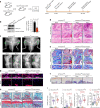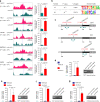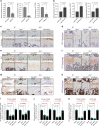Runx1 protects against the pathological progression of osteoarthritis
- PMID: 34876557
- PMCID: PMC8651727
- DOI: 10.1038/s41413-021-00173-x
Runx1 protects against the pathological progression of osteoarthritis
Abstract
Runt-related transcription factor-1 (Runx1) is required for chondrocyte-to-osteoblast lineage commitment by enhancing both chondrogenesis and osteogenesis during vertebrate development. However, the potential role of Runx1 in joint diseases is not well known. In the current study, we aimed to explore the role of Runx1 in osteoarthritis induced by anterior cruciate ligament transaction (ACLT) surgery. We showed that chondrocyte-specific Runx1 knockout (Runx1f/fCol2a1-Cre) aggravated cartilage destruction by accelerating the loss of proteoglycan and collagen II in early osteoarthritis. Moreover, we observed thinning and ossification of the growth plate, a decrease in chondrocyte proliferative capacity and the loss of bone matrix around the growth plate in late osteoarthritis. We overexpressed Runx1 by adeno-associated virus (AAV) in articular cartilage and identified its protective effect by slowing the destruction of osteoarthritis in cartilage in early osteoarthritis and alleviating the pathological progression of growth plate cartilage in late osteoarthritis. ChIP-seq analysis identified new targets that interacted with Runx1 in cartilage pathology, and we confirmed the direct interactions of these factors with Runx1 by ChIP-qPCR. This study helps us to understand the function of Runx1 in osteoarthritis and provides new clues for targeted osteoarthritis therapy.
© 2021. The Author(s).
Conflict of interest statement
The authors declare no competing interests.
Figures







Similar articles
-
Runx1 is a key regulator of articular cartilage homeostasis by orchestrating YAP, TGFβ, and Wnt signaling in articular cartilage formation and osteoarthritis.Bone Res. 2022 Oct 28;10(1):63. doi: 10.1038/s41413-022-00231-y. Bone Res. 2022. PMID: 36307389 Free PMC article.
-
Runx1 alleviates osteoarthritis progression in aging mice.J Histotechnol. 2024 Jun;47(2):57-67. doi: 10.1080/01478885.2023.2281790. Epub 2023 Nov 15. J Histotechnol. 2024. PMID: 37966852
-
Runx1 up-regulates chondrocyte to osteoblast lineage commitment and promotes bone formation by enhancing both chondrogenesis and osteogenesis.Biochem J. 2020 Jul 17;477(13):2421-2438. doi: 10.1042/BCJ20200036. Biochem J. 2020. PMID: 32391876 Free PMC article.
-
The roles of Runx1 in skeletal development and osteoarthritis: A concise review.Heliyon. 2022 Dec 25;8(12):e12656. doi: 10.1016/j.heliyon.2022.e12656. eCollection 2022 Dec. Heliyon. 2022. PMID: 36636224 Free PMC article. Review.
-
[RESEARCH PROGRESS OF PATHOLOGY OF ENDOCHONDRAL OSSIFICATION IN OSTEOARTHRITIS].Zhongguo Xiu Fu Chong Jian Wai Ke Za Zhi. 2016 Dec 8;30(12):1556-1561. doi: 10.7507/1002-1892.20160320. Zhongguo Xiu Fu Chong Jian Wai Ke Za Zhi. 2016. PMID: 29786351 Review. Chinese.
Cited by
-
Annexin A5 derived from matrix vesicles protects against osteoporotic bone loss via mineralization.Bone Res. 2023 Nov 9;11(1):60. doi: 10.1038/s41413-023-00290-9. Bone Res. 2023. PMID: 37940665 Free PMC article.
-
Progress in osteoarthritis research by the National Natural Science Foundation of China.Bone Res. 2022 May 24;10(1):41. doi: 10.1038/s41413-022-00207-y. Bone Res. 2022. PMID: 35610209 Free PMC article. Review.
-
Leveraging Whole-Genome Resequencing to Uncover Genetic Diversity and Promote Conservation Strategies for Ruminants in Asia.Animals (Basel). 2025 Mar 13;15(6):831. doi: 10.3390/ani15060831. Animals (Basel). 2025. PMID: 40150358 Free PMC article. Review.
-
Early human fetal lung atlas reveals the temporal dynamics of epithelial cell plasticity.Nat Commun. 2024 Jul 13;15(1):5898. doi: 10.1038/s41467-024-50281-5. Nat Commun. 2024. PMID: 39003323 Free PMC article.
-
Runx1 is a key regulator of articular cartilage homeostasis by orchestrating YAP, TGFβ, and Wnt signaling in articular cartilage formation and osteoarthritis.Bone Res. 2022 Oct 28;10(1):63. doi: 10.1038/s41413-022-00231-y. Bone Res. 2022. PMID: 36307389 Free PMC article.
References
Grants and funding
LinkOut - more resources
Full Text Sources

